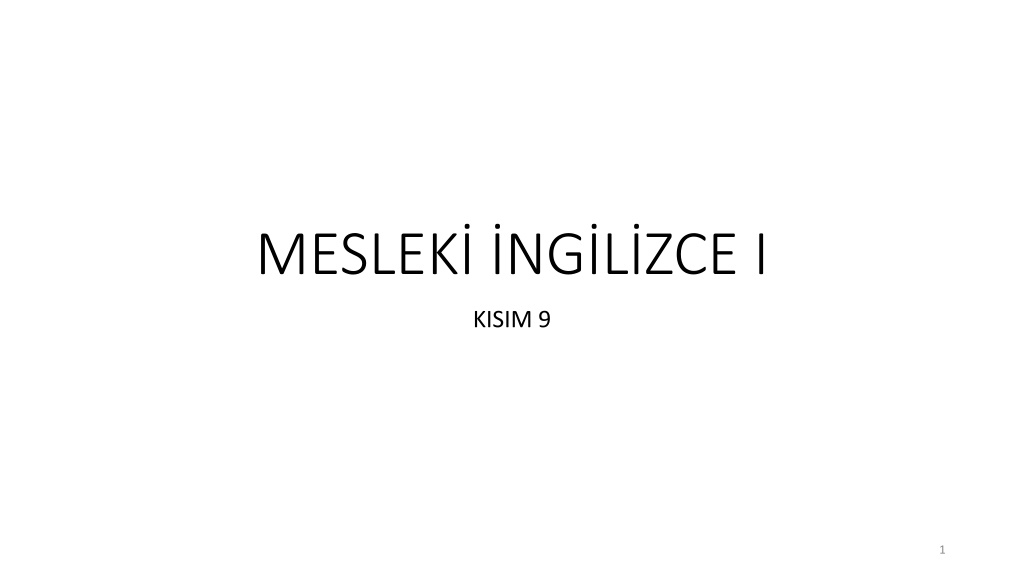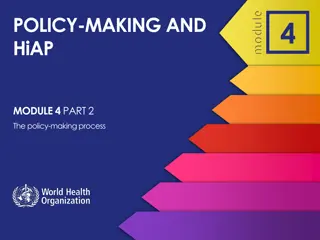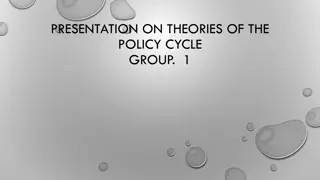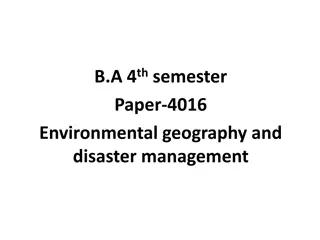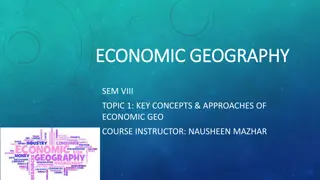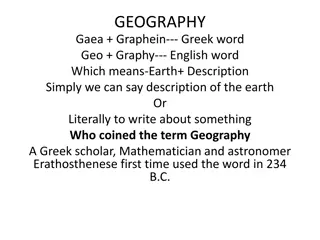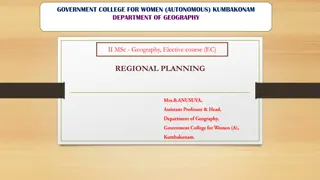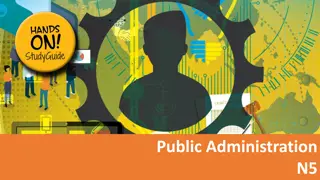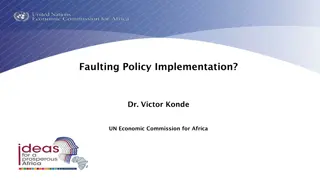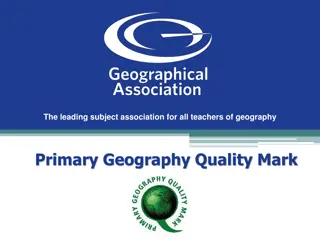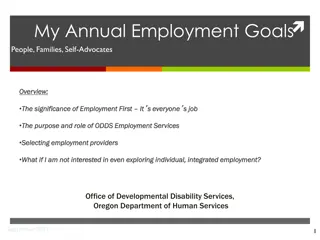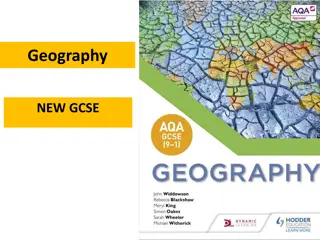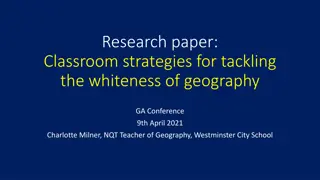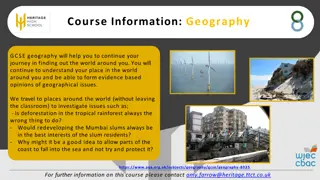Integrated Geography and Policy Making
Human geography focuses on the study of patterns shaping societies, while integrated geography explores spatial interactions between humans and the environment. Policies guide decision-making processes to achieve rational outcomes, offering assistance in both subjective and objective scenarios.
Download Presentation

Please find below an Image/Link to download the presentation.
The content on the website is provided AS IS for your information and personal use only. It may not be sold, licensed, or shared on other websites without obtaining consent from the author.If you encounter any issues during the download, it is possible that the publisher has removed the file from their server.
You are allowed to download the files provided on this website for personal or commercial use, subject to the condition that they are used lawfully. All files are the property of their respective owners.
The content on the website is provided AS IS for your information and personal use only. It may not be sold, licensed, or shared on other websites without obtaining consent from the author.
E N D
Presentation Transcript
MESLEK NGLZCE I KISIM 9 1
Human Geography Human geography is a branch of geography that focuses on the study of patterns and processes that shape the human society. It encompasses the human, political, cultural, social, and economic aspects. BRANCH: DAL PATTERN: R NT PROCESS: S RE SHAPE: B M ENCOMPASS: KU ATMAK: ASPECT: HAL-G R N 2
Integrated geography Integrated geography is concerned with the description of the spatial interactions between humans and the natural world. It requires an understanding of the traditional aspects of physical and human geography, as well as the ways that human societies conceptualize the environment. DESCRIPTION: TANIM SPATIAL: MEKANSAL INTERACTION: ETK LE M REQUIRE: HT YA DUYMAK ASPECT: HAL G R N CONCEPTUALIZE: 3
Integrated geography Integrated geography has emerged as a bridge between the human and the physical geography, as a result of the increasing specialisation of the two sub-fields. EMERGE: ORTAYA IKMAK BRIDGE: K PR SUB-FIELD: ALT SAHA 4
Integrated geography Furthermore, as human relationship with the environment has changed as a result of globalization and technological change, a new approach was needed to understand the changing and dynamic relationship. Examples of areas of research in the environmental geography include: emergency management, environmental management, sustainability, and political ecology. GLOBALIZATION: K RESELLE ME FURTHERMORE: DAHASI APPROACH: YAKLA IM DYNAMIC: D NAM K AREA: SAHA EMERGENCY: AC L YET SUSTAINABILITY: S RD R LEB L RL K 5
policy A policy is a deliberate system of principles to guide decisions and achieve rational outcomes. A policy is a statement of intent, and is implemented as a procedure or protocol. Policies are generally adopted by a governance body within an organization. Policies can assist in both subjective and objective decision making. DELIBERATE: NCEL KL GUIDE: REHBER OLMAK ACHIEVE: ELDE ETMEK RATIONAL: RASYONEL OUTCOME: IKTI INTENT: N YET IMPLEMENT: UYGULAMAK GOVERNANCE: Y NET M ASSIST: YARDIMCI OLMAK ADOPT: ADAPTE OLMAK 6
policy Policies to assist in subjective decision making usually assist senior management with decisions that must be based on the relative merits of a number of factors, and as a result are often hard to test objectively, e.g. work-life balance policy. In contrast policies to assist in objective decision making are usually operational in nature and can be objectively tested, e.g. password policy SUBJECTIVE: SUBJEKT F SENIOR: KIDEML RELATIVE: G RECE MERIT: FAZ LET OBJECTIVELY: NESNEL OLARAK BALANCE: DENGE CONTRAST: ZIT PASSWORD: FRE 7
Public administration Public administration is the implementation of government policy and also an academic discipline that studies this implementation and prepares civil servants for working in the public service. As a "field of inquiry with a diverse scope" its "fundamental goal... is to advance management and policies so that government can function." IMPLEMENTATION: UYGULAMA PREPARE: HAZIRLAMAK CIVIL SERVANT: MEMUR INQUIRY: ARA TIRMAK DIVERSE SCOPE: AYRI ALAN FUNDAMENTAL: TEMEL GOAL: AMA FUNCTION: LEMEK 8
Public administration Some of the various definitions which have been offered for the term are: "the management of public programs"; the "translation of politics into the reality that citizens see every day";and "the study of government decision making, the analysis of the policies themselves, the various inputs that have produced them, and the inputs necessary to produce alternative policies VARIOUS: E TL OFFER: TEKL F ETMEK TRANSLATION: EV R REALITY: GER EKL K CITIZEN: VATANDA ANALYSIS: ANAL Z INPUT: G RD NECESSARY: GEREKL PRODUCE: RETMEK ALTERNATIVE: ALTERNAT F 9
History of Public management In the US, civil servants and academics such as Woodrow Wilson promoted American civil service reform in the 1880s, moving public administration into academia. US: AMER KA B RLE K DEV. ACADEMIC: AKADEM SYEN PROMOTE: Y KSELTMEK REFORM: D ZENLEME-REFORM MOVE: HAREKET ETMEK ACADEMIA: AKADEM K CAM A 10
History of Public management However, "until the mid-20th century and the dissemination of the German sociologist Max Weber's theory of bureaucracy" there was not "much interest in a theory of public administration." The field is multidisciplinary in character; one of the various proposals for public administration's sub-fields sets out six pillars, including human resources, organizational theory, policy analysis and statistics, budgeting, and ethics. MID-: ORTALARI-EK- DISSEMINATION: YAYMA SOCIOLOGIST: SOSYOLOG INTEREST: IKAR BUREAUCRACY: B ROKRAS PROPOSAL: TEKL F PILLAR: S TUN INCLUDING: NE ALAN STATISTICS: STAT ST K BUDGETING: B T ELEME ETHICS: AHLAK-ET K 11
Business administration The administration of a business includes the performance or management of business operations and decision making, as well as the efficient organization of people and other resources, to direct activities toward common goals and objectives. INCLUDE: DAH L ETMEK PERFORMANCE: PERFORMANS DECISION: KARAR PEOPLE: HALK- NSANLAR RESOURCE: KAYNAK TOWARD:- KAR I COMMON: M TEREK GOAL: HEDEF 12
Business administration ASSOCIATED: L K L FINANCE: F NANS QUESTION: SORU UNDERSTAND: ANLAMAK TOPIC: KONU BROADER: DAHA GEN REFER TO: ATFETMEK In general, administration refers to the broader management function, including the associated finance, personnel and MIS services. In answering the question of what is business administration, it is important to understand the history of the topic. 13
History of business administration- TRACE BACK: K KEN TARAMAK DEEP: DER N ROOT: K K EDUCATION: E T M Higher education in the United States has very deep roots. The history of business administration be traced back to 1911 and Fredrerick Winslow Taylor. 14
History of business administration- In 1911 Taylor published The Principles of Scientific Managment. Why is this important? The publication encouraged managers to view employees as specialized and replaceable. In other words, he believed that managers should focus on training workers to reduce inefficiency and to work to grow a corporation. This was a major shift in thinking. ENCOURAGE: CESARETLEND RMEK SPECIALIZE: ZELLE T RMEK TRAINING: E T M REDUCE: AZALTMAK INEFFICIENCY: VER MS ZL K GROW: B Y TMEK-B Y MEK CORPORATION: KURUM MAJOR: BA LICA SHIFT:DE M FOCUS ON: ODAKLANMAK BELIEVE: NANMAK REPLACEABLE: YER DOLDURULAB L R VIEW: F K R-G R 15
History of business administration- COMMITTEE: KOM TE DIVISION: B L M AUTONOMY: OTONOM ALLOW: Z N VERMEK GROW: YET T RMEK- EMULATE: ZENMEK REST: GER KALAN CONTRIBUTE: KATKI SA LAMAK CORPORATION: B RL KTEL K In 1923 Alfred P Sloan became president of GM. As president, he introduced the concept of managing by central executive committe and decentralized each operating division. By giving each division autonomy, they were allowed to grow the business in new ways. This business structure was then emulated by other corporations throught the rest of the century. The National Research Council also contributed to the history of business administration In 1927. 16
History of business administration- INTENT: N YET EXPERIMENT: DENEY CO-FUNDED: E SERMAYEL MOTIVATE: MOT VE ETMEK ERA: A ATTEMPT: TE EBB S ETMEK CONDITION: KONUM APPRECIATE: TAKD R ETMEK EFFICIENCY: VER M FURTHER: TE That year, the Council co-funded the 'Hawthorne Experiments'. The intent of these experiments was to determine what motivated workers. In an era where companies where changing the way they were thinking of employees, understanding worker motivation was an attempt to further increase efficiency. The study determined that workers are not only motivated by financial gain and good working conditions. It was also important to workers that they feel appreciated and were interested in their work. 17
History of business administration SUPERVISORY: DENET M WANDERING : GEZ C CHATTING WITH : KONU MAK BENEFIT: FAYDA APPROACHABLE: YAKLA ILAB L R TRUST: G VEN ACCOUNTABILITY: HESAP VEREB L RL K MORALE : AHLAK PRODUCTIVITY: VER ML L K In 1938 Hewlet-Packard was formed. Why is this important you ask? Some years later, HP introduced the supervisory style of wandering around the offices and chatting with employees. The expected benefit here was to make the boss more approachable and connected to employees. It is believed that this style increases trust, accountability, morale and productivity. 18
History of business administration The 1950s brought the concept of 'quality management'. Founded by W Edwards Deming, this concept contains 14 major points. Each of the points were intended to create a more efficient workplace. Points included concepts such as: Industries and economics are always changing Communicate to all employees the purpose of the company On the job training Focus on morale and trust Maybe obvious to us in our time, but these concepts were quite new when introduced by Deming. QUALITY: N TEL K INTEND: N YET ETMEK INCLUDE: ERMEK CONCEPT: KAVRAM COMMUNICATE: LET M KURMAK QUITE: EPEYCE INTRODUCE: TANI TIRMAK CONTAIN: YER VERMEK ERMEK CREATE: YARATMAK 19
History of business administration DOCTORINE: DOKTR N IDEA: F K R LEADER: L DER KEEP: MUHAFAZA ETMEK HAPPY: MUTLU URGE: D RTMEK SCENE: SAHNE FOLLOW UP: TAK P ETMEK The Doctorine of Transformational Leadership made it's way onto the scene in 1978. Created by James MacGregor Burns, the works urged leaders to think about how companies and employees could benefit society. This was followed up by the concept of Servent Leadership in 1990. This main idea of this concept was that the main role of a leader is to keep employees happy. 20
Economics Economics is the social science that studies the production, distribution, and consumption of goods and services. Economics focuses on the behaviour and interactions of economic agents and how economies work. DISTRIBUTION: DA ITIM CONSUMPTION: T KET M BEHAVIOUR: DAVRANI INTERACTION: ETK LE M AGENT: GERE -ARACI GOODS AND SERVICES: R N VE H ZMETLER 21
Microeconomics ANALYZE: ANAL Z ETMEK MARKET: P YASA-PAZAR OUTCOME: IKTI INCLUDE: YER VERMEK ERMEK HOUSEHOLD: HANE HALKI FIRM: F RMA BUYER: M TER SELLER: SATICI ELEMENT: UNSUR Microeconomics analyzes basic elements in the economy, including individual agents and markets, their interactions, and the outcomes of interactions. Individual agents may include, for example, households, firms, buyers, and sellers. 22
Macroeconomics ENTIRE: B T N SAVING: TASARRUF AGGREGATE: K MELE MEK INFLATION: ENFLASYON MONETARY: PARASAL FISCAL: MAL AFFECT: ETK LEMEK ADDRESS: H TAP ETMEK LABOUR: EMEK- MEANING: ANLAMINA GELMEK Macroeconomics analyzes the entire economy (meaning aggregated production, consumption, savings, and investment) and issues affecting it, including unemployment of resources (labour, capital, and land), inflation, economic growth, and the public policies that address these issues (monetary, fiscal, and other policies). 23
Macroeconomics NORMATIVE: NORMAT F BEHAVIOURAL: DAVRANI SAL ADVOCATE: SAVUNMAK APPLIED: UYGULAMALI MAINSTREAM: ANA AKIM HETERODOX: D ZENE KAR I DESCRIBE: TANIMLAMAK Other broad distinctions within economics include those between positive economics, describing "what is", and normative economics, advocating "what ought to be"; between economic theory and applied economics; between rational and behavioral economics; and between mainstream economics and heterodox economics. 24
History of Economics There are a variety of modern definitions of economics; some reflect evolving views of the subject or different views among economists. Scottish philosopher Adam Smith (1776) defined what was then called political economy as "an inquiry into the nature and causes of the wealth of nations", in particular as: PHILOSOPHER: F LOZOF DEFINITION: TANIM REFLECT: YANSITMAK AMONG: ARASINDA WEALTH: ZENG NL K CAUSE: SEBEP OLMAK WEALTH: ZENG NL K PARTICULAR: ZEL NATION: M LLET 25
History of Economics a branch of the science of a statesman or legislator [with the twofold objectives of providing] a plentiful revenue or subsistence for the people ... [and] to supply the state or commonwealth with a revenue for the public services. STATESMAN: DEVLET ADAMI LEGISLATOR: YASAMACI PLENTIFUL: OK BEREKETL COMMONWEALTH: M LLETLER TOPLULU U ( NG L Z) REVENUE: HASILA PUBLIC: KAMU SUBSISTENCE: GE M TWOFOLD: K M SL 26
History of Economics Jean-Baptiste Say (1803), distinguishing the subject from its public-policy uses, defines it as the science of production, distribution, and consumption of wealth. On the satirical side, Thomas Carlyle (1849) coined "the dismal science" as an epithet for classical economics, in this context, commonly linked to the pessimistic analysis of Malthus (1798). DISTINGUISH: AYIRT ETMEK SUBJECT: ZNE DISTRIBUTION: DA ITIM SATIRICAL: YERG L SIDE: Y N TARAF DISMAL: SIKINTILI EPITHET: YAKI TIRMA LINK: BA LANTI KURMAK PESSIMISTIC: KARAMSAR COIN: S ZC K T RETMEK 27
History of Economics John Stuart Mill (1844) defines the subject in a social context as: The science which traces the laws of such of the phenomena of society as arise from the combined operations of mankind for the production of wealth, in so far as those phenomena are not modified by the pursuit of any other object. PHENOMENA: FEONOMEN ARISE: ARTTIRMAK MODIFY: DE T RMEK PURSUIT: TAK P TRACE: ZLEMEK Z S RMEK MANKIND: BE ER YET SO FAR: MD YE KADAR 28
History of Economics Alfred Marshall provides a still widely cited definition in his textbook Principles of Economics (1890) that extends analysis beyond wealth and from the societal to the microeconomic level: Economics is a study of man in the ordinary business of life. It enquires how he gets his income and how he uses it. Thus, it is on the one side, the study of wealth and on the other and more important side, a part of the study of man. CITE: ATIFTA BULUNMAK EXTEND: GEN LETMEK UZATMAK BEYOND: TES SOCIETAL: TOPLUMSAL ORDINARY: SIRADAN INCOME: GEL R THUS: BUNDAN DOLAYI PROVIDE: SA LAMAK, TEM N STILL: HALA TEXTBOOK: DRS K TABI WIDELY: GEN APLI OLARAK 29
History of Economics Lionel Robbins (1932) developed implications of what has been termed "[p]erhaps the most commonly accepted current definition of the subject": Economics is a science which studies human behaviour as a relationship between ends and scarce means which have alternative uses PERHAPS: BELK IMPLICATION: UYGULAMA COMMONLY: YAYGIN EK LDE SCARCE: NAD R 30
History of Economics Game theory is a branch of applied mathematics that considers strategic interactions between agents, one kind of uncertainty. It provides a mathematical foundation of industrial organization, discussed above, to model different types of firm behaviour, for example in an oligopolistic industry (few sellers), but equally applicable to wage negotiations, bargaining, contract design, and any situation where individual agents are few enough to have perceptible effects on each other. In behavioural economics, it has been used to model the strategies agents choose when interacting with others whose interests are at least partially adverse to their own. APPLIED: UYGULAMALI FOUNDATION: KURUM OLIGOPOLISTIC: OL GOPOLC WAGE: MAA NEGOTIATION: M ZAKERE BARGAIN: PAZARLIK YAPMAK PERCEPTIBLE: FARKED LEB LEN INTERACT WITH: TEMAS KURMAK LEAST: EN AZ ADVERSE: TERS PARTIALLY: KISMEN 31
History of Economics In this, it generalizes maximization approaches developed to analyse market actors such as in the supply and demand model and allows for incomplete information of actors. The field dates from the 1944 classic Theory of Games and Economic Behavior by John von Neumann and Oskar Morgenstern. It has significant applications seemingly outside of economics in such diverse subjects as formulation of nuclear strategies, ethics, political science, and evolutionary biology GENERALIZE: GENELLEMEK INCOMPLETE: TAM OLMAYAN ALLOW: Z N VERMEK SEEMINGLY: G R N RDE DIVERSE: E TL OUTSIDE: DI TAN FORMULATION: FORM LLE T RME EVOLUTIONARY: EVR MC SIGNIFICANT: NEML SUPPLY: ARZ-ARZ ETMEK DEMAND: TALEP-TALEP ETMEK APPLICATION: UYGULAMA 32
History of Economics Some subsequent comments criticized the definition as overly broad in failing to limit its subject matter to analysis of markets. From the 1960s, however, such comments abated as the economic theory of maximizing behaviour and rational-choice modelling expanded the domain of the subject to areas previously treated in other fields. There are other criticisms as well, such as in scarcity not accounting for the macroeconomics of high unemployment SUBSEQUENT: SONRADAN GELEN COMMENT: YORUM FAILING: ZAYIFLIK-ZAYIFLAMAK MATTER: KONU ABATE: EK LMEK EXPAND: GEN LETMEK DOMAIN: ALAN ALI MA ALANI TREAT: MUAMELE ETMEK ACCOUNT FOR: HESAP VERMEK CRITICIZE: ELE T RMEK OVERLY BROAD: FAZLASIYLA GEN APTA 33
History of Economics Milton Friedman effectively took many of the basic principles set forth by Adam Smith and the classical economists and modernized them. One example of this is his article in the 13 September 1970 issue of The New York Times Magazine, in which he claims that the social responsibility of business should be "to use its resources and engage in activities designed to increase its profits ... (through) open and free competition without deception or fraud. MODERNIZE: MODERN ZE TMEK CLAIM: DD A ETMEK ENGAGE IN: DAH L OLMAK PROFIT: KAR COMPETITION: REKABET DECEPTION: ALDATMA FRAUD: SAHTEKARLIK SET FORTH: NG RMEK 34
History of Economics In 1988, Marilyn Waring published the book If Women Counted, in which she argues that the discipline of economics ignores women's unpaid work and the value of nature; according to Julie A. Nelson, If Women Counted "showed exactly how the unpaid work traditionally done by women has been made invisible within national accounting systems" and "issued a wake-up call to issues of ecological sustainability. PUBLISH: BASMAK ARGUE: DD A ETMEK IGNORE: G RMEZDEN GELMEK UNPAID: DENMEM INVISIBLE:G R NMEZ WAKE-UP:UYANMAK ISSUE: KONU ECOLOGICAL: EKOLOJ K 35
History of Economics A 2002 International Monetary Fund study looked at "consensus forecasts" (the forecasts of large groups of economists) that were made in advance of 60 different national recessions in the 1990s: in 97% of the cases the economists did not predict the contraction a year in advance. On those rare occasions when economists did successfully predict recessions, they significantly underestimated their severity FORECAST: TAHM N ETMEK- KEHANETTE BULUNMAK CONSENSUS: F K R B RL RECESSION: DURGUNLUK PREDICT: TAHM N ETMEK CONTRADICTION: AYKIRILIK RARE: NAD R OCCASION: FIRSAT SIGNIFICANTLY: HAYAT OLARAK UNDERESTIMATE: ALTTAN ALMAK, K MSEMEK SEVERITY: DDET 36
International relations International relations (IR) or international affairs, depending on academic institution, is either a field of political science, an interdisciplinary academic field similar to global studies, or an entirely independent academic discipline in which students take a variety of internationally focused courses in social science and humanities disciplines. DEPEND ON: BA LI OLARAK INSTITUTION: KURUM FIELD: SAHA ENTIRELY: T MDEN VARIETY: E TL L K COURSE: DERS HUMANITY: NSANLIK 37
International relations In all cases, the field studies relationships between political entities (polities) such as sovereign states, inter-governmental organizations (IGOs), international non-governmental organizations (INGOs), other non-governmental organizations (NGOs), and multinational corporations (MNCs), and the wider world-systems produced by this interaction. International relations is an academic and a public policy field, and so can be positive and normative, because it analyses and formulates the foreign policy of a given state. STATE: DEVLET WIDER: DAHA GEN NGO: STK-S V K TOPLUM KURULU U MNC: ULUSLARARASI KURUMLAR IGO: H K METLER ARASI RG TLER 38
History of International Relations As political activity, international relations dates from the time of the Greek historian Thucydides (c. 460 395 BC), and, in the early 20th century, became a discrete academic field (no. 5901 in the 4- digit UNESCO Nomenclature) within political science. In practice, international relations and international affairs forms a separate academic program or field from political science, and the courses taught therein are highly interdisciplinary. DISCRETE: AYRIK AFFAIR: L K THEREIN: BURADA SEPARETE: AYRI HISTORIAN:TAR H WITHIN: ND 39
History of International Relations For example, international relations draws from the fields of: technology and engineering, economics, communication studies, history, international law, demography, philosophy, geography, social work, sociology, anthropology, criminology, psychology, gender studies, cultural studies, culturology, and diplomacy. The scope of international relations comprehends globalization, diplomatic relations, state sovereignty, international security, ecological sustainability, nuclear proliferation, nationalism, economic development, global finance, as well as terrorism and organized crime, human security, foreign interventionism, and human rights, as well, as, more recently, comparative religion. DIPLOMACY: D PLOMAS GENDER: C NS YET SCOPE: SAHA COMPREHEND: KAVRAMAK SECURITY: G VENL K TERRORISM: TER R ZM HUMAN RIGHT: NSAN HAKKI PROLIFERATION: O ALMA SOVEREIGNITY: HAK M YET NATIONALISM: M LL YET L K INTERVENTIONISM:M DAHALEC L K COMPARATIVE: KAR ILA TIRMALI 40
History of International Relations The history of international relations can be traced back to thousands of years ago; Barry Buzan and Richard Little, for example, consider the interaction of ancient Sumerian city-states, starting in 3,500 BC, as the first fully-fledged international system THOUSAND: B N CONSIDER: D NMEK ANCIENT: ANT K-ESK -KAD M FULLY-FLEDGED: TA TE EKK LL 41
History of International Relations The history of international relations based on sovereign states is often traced back to the Peace of Westphalia of 1648, a stepping stone in the development of the modern state system. Prior to this the European medieval organization of political authority was based on a vaguely hierarchical religious order. Contrary to popular belief, Westphalia still embodied layered systems of sovereignty, especially within the Holy Roman Empire.More than the Peace of Westphalia, the Treaty of Utrecht of 1713 is thought to reflect an emerging norm that sovereigns had no internal equals within a defined territory and no external superiors as the ultimate authority within the territory's sovereign borders. MEDIEVAL: ORTA A AUTHORITY: OTOR TE ORDER: D ZEN BELIEF: NAN TREATY: ANTLA MA REFLECT: YANSITMAK TERRITORY: B LGE ULTIMATE: N HA BORDER: SINIR 42
History of International Relations The centuries of roughly 1500 to 1789 saw the rise of the independent, sovereign states, the institutionalization of diplomacy and armies. The French Revolution added to this the new idea that not princes or an oligarchy, but the citizenry of a state, defined as the nation, should be defined as sovereign. Such a state in which the nation is sovereign would thence be termed a nation-state (as opposed to a monarchy or a religious state). CENTURY: Y ZYIL RISE: Y KSELMEK INTITUTIONALIZATION: KURUMSALLA MA OLIGARCHY: OL GAR CITIZENRY: T M VATANDA LAR MONARCHY: MONAR OPPOSE: KAR I IKMAK ARMY: ORDU REVOLUTION: DEVR M TERM: TER M PRINCE: PRENS 43
History of International Relations The term republic increasingly became its synonym. An alternative model of the nation-state was developed in reaction to the French republican concept by the Germans and others, who instead of giving the citizenry sovereignty, kept the princes and nobility, but defined nation-statehood in ethnic- linguistic terms, establishing the rarely if ever fulfilled ideal that all people speaking one language should belong to one state only. REPUBLIC: CUMHUR YET REACTION: TEPK STATEHOOD: DEVLET OLMA LINGUISTIC: D L FULLFILL: TAMAMLAMAK BELONG TO: A T OLMAK NOBILITY: SOYLULUK RARELY: NAD REN SYNONYM: ANLAMDA INSTEAD OF: YER NE 44
History of International Relations The same claim to sovereignty was made for both forms of nation-state. (It is worth noting that in Europe today, few states conform to either definition of nation-state: many continue to have royal sovereigns, and hardly any are ethnically homogeneous.) ROYAL:AS L ETHNICALLY: ETN K OLARAK HOMOGENEOUS: T RDE CLAIM TO: DD A ETMEK NOTING THAT: FADE EDEREK 45
History of International Relations The particular European system supposing the sovereign equality of states was exported to the Americas, Africa, and Asia via colonialism and the "standards of civilization". The contemporary international system was finally established through decolonization during the Cold War. However, this is somewhat over-simplified. While the nation- state system is considered "modern", many states have not incorporated the system and are termed "pre-modern". CIVILIZATION: MEDEN YET CONTEMPORARY: A DA DECOLONIZATION: BA IMSIZLI INI VERME OVER-SIMPLIFY: FAZLA BAS TLE T RMEK CONSIDER: D NMEK INCORPORATE: ERMEK PRE-MODERN: MODERN NCES COLONIALISM: KOLON LE ME EQUALITY: E TL K EUROPEAN: AVRUPALI EXPORT: HRA ETMEK SUPPOSE: VARSAYMAK 46
History of International Relations Further, a handful of states have moved beyond insistence on full sovereignty, and can be considered "post-modern". The ability of contemporary IR discourse to explain the relations of these different types of states is disputed. "Levels of analysis" is a way of looking at the international system, which includes the individual level, the domestic state as a unit, the international level of transnational and intergovernmental affairs, and the global level. FURTHER: TE INSISTENCE: ISRAR DOMESTIC: M LL TRANSNATIONAL: ULUSA IRI DISCOURSE: S YLEM 47
History of International Relations What is explicitly recognized as international relations theory was not developed until after World War I, and is dealt with in more detail below. IR theory, however, has a long tradition of drawing on the work of other social sciences. The use of capitalizations of the "I" and "R" in international relations aims to distinguish the academic discipline of international relations from the phenomena of international relations. DRAW ON: YARARLANMAK CAPITALIZATION: SERMAYELEND RME DISTINGUISH: AYIRT ETMEK UNTIL: - E DEK DEAL WITH: LE LG LENMEK TRADITION: GELENEK EXPLICITLY: A IK A RECOGNIZE: TANIMAK BELOW: ALTINDA AIM TO: AMA ED NMEK 48
History of International Relations Many cite Sun Tzu's The Art of War (6th century BC), Thucydides' History of the Peloponnesian War (5th century BC), Chanakya's Arthashastra (4th century BC), as the inspiration for realist theory, with Hobbes' Leviathan and Machiavelli's The Prince providing further elaboration. INSPIRATION: LHAM PROVIDE: TEM N ETMEK ELABORATION: DETAYLANDIRMA CITE: ATIF YAPMAK FURTHER: DAHASI 49
History of International Relations Similarly, liberalism draws upon the work of Kant and Rousseau, with the work of the former often being cited as the first elaboration of democratic peace theory. Though contemporary human rights is considerably different from the type of rights envisioned under natural law, Francisco de Vitoria, Hugo Grotius and John Locke offered the first accounts of universal entitlement to certain rights on the basis of common humanity. In the 20th century, in addition to contemporary theories of liberal internationalism, Marxism has been a foundation of international relations. DRAW UPON: YARARLANMAK PEACE: HUZUR, BARI CONSIDERABLY: NEML L DE ACCOUNT: HESAP HUMANITY: NSANLIK FOUNDATION: KURUM FORMER: NCEK THOUGH: FAKAT ENVISION: TASAVVUR ETMEK ENTITLEMENT: SALAH YET-DEVLET TARAFINDAN SUNULAN 50
